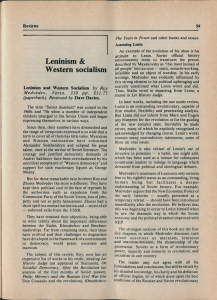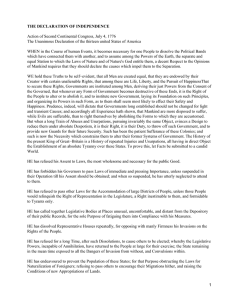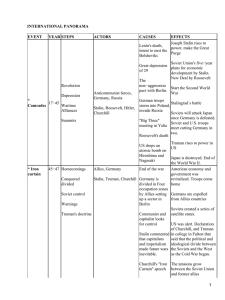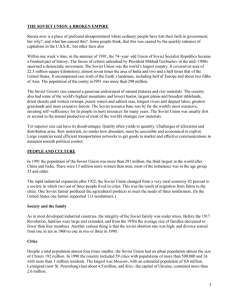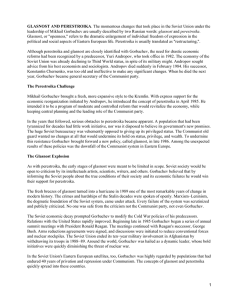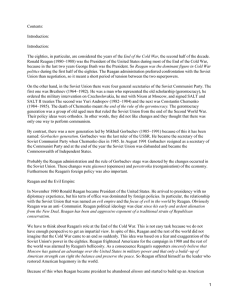Memorandum on the Soviet Doctrine and Practice with Respect to
Anuncio
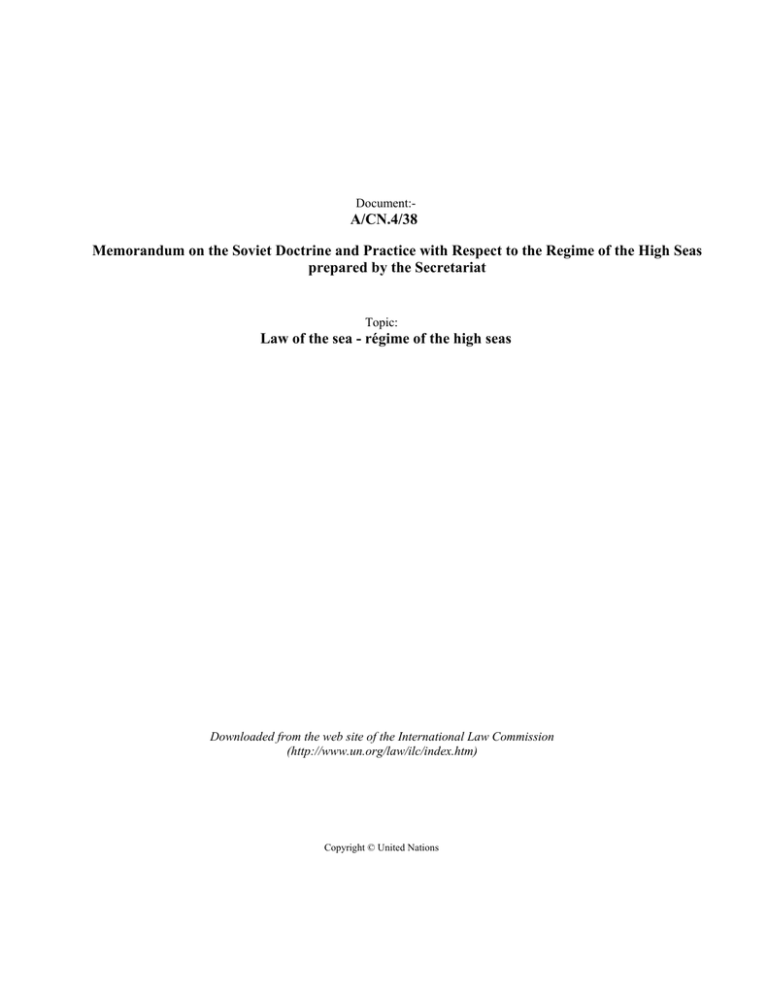
Document:- A/CN.4/38 Memorandum on the Soviet Doctrine and Practice with Respect to the Regime of the High Seas prepared by the Secretariat Topic: Law of the sea - régime of the high seas Downloaded from the web site of the International Law Commission (http://www.un.org/law/ilc/index.htm) Copyright © United Nations UNITED NATIONS GENERAL ASSEMBLY GJ33EAI A/CK.V33 21 November 1950 GSIGBLALJ EKGXISH Second ceso OE TE3 SCf^ET DOCTBira j ^ ¥ITE IGSFJICT TO T E TEI] Himi SSA3 (Prepared "by the Secretariat) /.TABLE A/CKA/38 l-i/'CI; .4/3*1/ TADI22 M Oi1 TEH SEA3 - A Gi II. III. IV. 3 'ZS-. EIGE SH BJG11T3 m TxZ, ZIGrH B3A3 12 HS0APITULA1TI0K IT /SOVIET DOCTRINE \ ' -r- I SOVIET DOCTRDJE AM) PRACTICE W33H RESPECT TO TBE -REGIME OF THE HIGH SEAS I. IEEEDGM OF THE SEAS - A GENERAL PRINCIPLE A Soviet text-book places the UoS.S.R. alongside other states in recognizing the freedom of the seas. 1. The statue of the high Beas. The waters of oceans and seas are subject to the common use of all, states for the purpose of navigation, "business, etc. In the science of international lay and in the practice of states the spaces of the sea, "being in common use of all peoples,, are,, called the "high seas". Littoral,countries of a given sea may establish their authority (jurisdiction) over only a determined strip, of its waters, which are contiguous to, its shore'. (institut Prava Akademii Nauk S.S.S.R., Mezhdunarodnoe Pravo, Moscow, 19^7, P- 236 - Institute of Law of the Academy of Sciences of the TJSS.S.R., International Law). The U.S.S.R.-'s particular interest in the principle has "been stated as follows-: The question of the measure and substance of the concept of freedom of the seas has great importance for tho U,S.S R. as a great naval power, interested in unintorruptedcommunication'between tho 14 seas and 3 oceans washing its shores. The Soviet naval forces, which-were given the task even "before the second world war of having "a sea and "ocean float worthy of our .great cause,," must "be certain of a free exit to the sea lanes,of the world. furthermore, the problem of freedom of the seas now has a second more general reason for "being important. During the course of the first and second world wars, and even during the interval between them, the question of freedom, of the seas became much more complicated. In that very poriod there arose to the first magnitude the effort of the great capitalist maritime powers to seize unlimited control over the seas; to subordinate the force of law to the rule of physical force on the seas.; to do away with the freedom of the seas and to conduct on their surfaces a severe economic war. The piracy of states on the sea rose to a position of prowess. (S. Vyshnepol'skii, Freedom of the Seas in the Epoch of Imperialism, Sovetskoe Gosudarstvo i Pravo, No. 1, 19^9, p. 13. - Soviet State and Law) ^/Translated into English in Current Digest of the Soviet Press, American Council of Learned Societies, Washington, D. C , Vol. I, No. 16, 17 May P. 37- On 1 January 19^2, the U.S.S.R. adhered with other states to the principles of the Atlantic Charter, point 7 of which reads: Seventh, such a peace should enable all mon to traverse the high seas and oceans without hindrance. /(For text of A/CE.4/36 Page 4 (For text of Declaration of adherenc-.. aee Soviet Foreign Policy During the Patriotic War, Documents and Materials, Vol. I, June 22, 1 December 31, 19^3, trans, "by Andrew Rothstein, London, no date, p. Ilk, and CCIV:.38l HOTS). A series of notes was addressed, by the U.S.S.R. to the United States in , the first of which on 30 January 19^8 protested against air inspection of Soviet ships passing through waters near Japan. In the report of the Telegraph Agency of the Soviet Union (lass) it was Btated: In connection with this the Ministry of Foreign Affaire on 30 January of this year directed to the American Itabassy in Moscow a note in which, having communicated the aforementioned acts, of American airplanesj, the attention of the. Government of the U.S.A. was called to the aforementioned violation of the freedom, of commercial navigation. The Ministry of Foreign Affairs of the U.S.S.R., it was stated in the note, expects that the Government of the U.S.A. will give the nooessary orderB to the responsible American authorities not to permit such violations .in the future. (Pravda, Wo. ^ (IO77U), 2 February 19W, P. 2). The espousal of the principle of freedom, of the seas is found to be of early origin in EuBsian history. Professor Eozhevnikov in hie 19^8 text-'book feels that it f^uidetas 2ugo G-rotiue* Ho writes: The principle of the freedom of the high seas and the impermissibility of subjecting it to the authority of individual -states was "brought forward by Russian diplomacy as early as the XVI' century, and later corroborated in. 1609 "by Hugo GrotiuB in his famous work "Mare .Liberum".. From the "beginning of the SVHI century it received general recognition and is today one of the fundamental principles of international law. The high seas may not "be occupied. (F. I. Kozhevnikov, Sovetskoe Gosudarstvo i Mezhdunarodnoe Pravo 1917^19^7. Opyt Istoriko^-pravovogo iBsledovaniya. - The Soviet State and International Law 1917-19^7.' The Experience of Historical Legal Research, Moscow, 19^8, p. 209). /ll. THE HIGH SEAS Page 5 U. THE ELQt SEAS DEFINED Certain, bodies of water called " seag11 are excluded from the doctrine of freedom of the seas. The U,SiS-JR. is especially concerned since some of the more important ones lie within its territory. A Soviet text (institut Prava, op. cit a , p. 237-238) states the principle, as follows (in, translation): 6. ^Closed Seas*« The principle of freedom of the high sead is not applied to closed spaces of water which cannot be reached from the ocean by seagoing vessels (for example, the Caspian, the Aral, the Dead Seas). These "seas" are, in effect, large lakes, falling under the regime of national waters or frontier waters, depending upon whether their shores belong to one or two states. The Caspian Sea in the treaties and practice of the U.S.S.R. and Iran is considered as a Soviet and Iranian- sea, on which navigation is permitted only to Iranian and Soviet ships. Commercial and business ships -on it are subject to the law of the flag when they are outside ports and roadsteads, but this does not exclude the right of supervision In special zones. The regime of the Caspian Sea is established by the "Treaty of Establishment, Commerce, and Navigation between the "Union of Soviet Socialist Republics and Iran," signed in Teheran on 27 August 1935 (Sbornik Deistvuyushchikh Dogovorov, S,qglashenli i Konventsii, Zaklyuchennykh s Inostrannymi Gosudarstvami,. Vol. 9, Moscow, 1938, p. 1929 - cited hereafter as Collection of Treaties, etc., U;S;S.R.; and; CtEPTE:299 LRTS). The pertinent article reads, in translation; Art, XIV. The Contracting Parties are agreed that in accordance with the principles proclaimed by the Treaty of 26 February 1921 between the Russian Socialist Federated Soviet Republic and. Persia there may be on. the entire Caspian Sea only ships belonging to the Union of Soviet Socialist Republics and Iran, as well as citizens and commercial and transport organizations of one of the two Contracting Parties sailing respectively under the flag of the Union of Soviet Socialist Republics or under the flag of Iran. Thev are likewise agreed that only persons which are their citizens may serve as crew on tie lr.'ships, The Arctic Ocean has been classified specially in Soviet literature, and, perhaps, is not considered as the "high seas" by the U.S»S.B.. This conclusion derives from a presentation by a Soviet jurist writing- in- the 1930*s, on the basis of an extension of the "sector" principle declared as governing Soviet claims to territory in the Arctic Ocean. The territorial declaration was set forth in a- decree of 15 April 1926 (Sobranie Zakonov i Sasporyazhenii 8.S.S.R,, 1926, Part I, Fo. 32, Art. 203 Collection of Laws and Orders of the TJ.SOS»S.) „ /Also translated somewhat differently, and incorrectly cited in T o A. Taracovzio, Soviets in the Arctic, Hew Tori, Macmillan, 1933, j?, 381/ /Art. 203 Page 6 Art,; 203 concerning the declaration of the land and islands located in the northern Frozen. Ocean as territory of the U.S,S»R. The Presidium of the Central •Executive CommitTiee of the U.S.S.B. decrees: All lands and islands whether discovered or 3.ikely to "be discovered in the future which are not recognized try- the Government of the U.S.S.B. at the time of publication of the present decree as the territory of some foreign state and which are located in the Northern Frozen Ocean to the north of the coast of the UeS ,S .Ro up to the North Pole between meridian 33°~^~35 ? f east from'Greenwich., passing along the eastern side of Vaida 3ay through the triangular mark on Cape Eekurski, and meridian 168°-49*-36*f west from Greenwich, passing along the middle of the strait-separating Batmaaov and Kruzhenstern Islands of the Diomede Archipelago lying in Bering Strait, are declared the territory of the U.S.S.R,, Based upon this decree W* Lakhtine, one-time Secretary-Member of the Committee of Direction of the Section of Aerial Law of the Union of Societies, "OsBoaviachim1' of the U.S.S.R., has argued as-follows in an article translated under- the title "Eights over the Arctic" (American Journal of Intem*-+-.tonal Law, Vol. 24.(1930), p. 703-at 712): The writer agrees with the opinion of E.A. Korovin* , It must "be remembered that some of the immovable ice fields are utilized for land communication, and that it is possible to establish there intermediate aerial stations, etc. We are of the opinion that floating ice should be assimilated legally to open polar seas, whilst ice formations that are more or less Immovable should enjoy a legal status equivalent-to polar territory. Polar States acquire,sovereignty over tfeem within the limits of their sectors of, attraction — — : Latentine then carries his argument further to include the open seas within the sector theory, and says (at p. 713): When taking into account, however, the peculiarities of the Arctic Ocean, and the legal status of the adjacent territories and ice, we are obliged to conclude that the doctrine of the high seas, if applied to the Arctic Ocean, is q.uite unsatisfactory. Sovereignty should attach to the Polar States over the Arctic Ocean within their sectors of attraction. The jurisdiction, however, should be qualified by the assurance to Foreign Powers of, the right of innocent passage of all naval vessels, although the littoral State should have the right to-regulate, control and even prohibit hunting and fishing. This principle has been practically recognized in the AngloAmerican -Bussian-Japanese convention of 1911 regulating fur-seal hunting; and in the conduct of the English and French In the Antarctic, as well as: the new naval policy of- the United States of America„ Thus the proposed legal status of the. high seas of the, Arctic, is, in its essential part, nearly identical with that of "territorial waters". /Laldrbine'B Page 7 Lakhtiness proposals have not "been incorporated In any declaration of the Soviet Government. No, such assimilation of the waters of the Antarctic Ocean to "territorial •waters" has "been made by the Soviet writers or the Soviet government. The possible Soviet attitude on Antarctic waters can "be determined only by its attit.uda toward territory in the Antarctic, Certain territory at the South, pole is said to "be subject to Soviet jurisdiction by right of discovery. In articles published in 19^9 the following has been said (in translation by the Current Digest of the Soviet Press): In £931 QI1^- 1939 Norway claimed Peter I Island, discovered by Russians in 182.1, and sunited* the expanse between the Australian and English (ff alfeland) sectors. -On January 27, 1939, the Soviet Government informed -Uforway that it could not accept this action bj Eorway as legal; and considered It necessary to reserve its point of view concerning, state '•'ownership of the territory discovered by the Russian navigator .Bsj.2.5,T.0g»uzen. It is Important to note that at the same time (January 1939) the U.S ,A» v in statements to Britain and France also reserved its point of .view, on. . sovereignty in the Antarctic, Thus the question remained open by virtue of'statements of the two great powers. The Soviet public and Soviet science could not neglect the problem of the Antarctic and forget the rights and interests of our Motherland in &1I3 question. Naturally the Geographical Society, of which both great Antarctic explorers - Belliasga'a.zea. and Lazarev - were members, cannot but take &ti interest in this question. (Eussian Discoveries in the Antarctic - at the General Meeting of the All-Soviet Geographical Society, Izvestia, 11 February 19^9/ p. 3, Pravda, ll February I9U9, p. 3. English translation in Current Digest of the ..Soviet Press, Washington, D.C., Vol. I, Ho. 6, 3 March 1949, p. ^3 at p. kh), Another indication of a claim to territory in the .Antarctic appeared four months later, in the following words (in translation ay the Current Digest of the Soviet Presss Idem, Vol. I, No. 2k, 12.July,19it-9, P-. 7 ) : However, in attempting to settle the question of the Antarctic without theparticipation of the Soviet Union,- the American expansionists are deliberately relegating to oblivion the.: fact that the right of priority in discovery of the Antarctic still belongs to the Soviet Union. —'— The right of priority in discovery of a number of Antarctic lands remains historically Russians, and, by succession, that of the U.S.S.R. Russia has never renounced her rights, and the Soviet Government has never given its consent for anv one to dispose of •. territory discovered by Russian seamen. With "cue reference above to the sectors of Australia and the Falkland lalands, Soviet writers may be indicating an extension of the "sector theory11 to territory in the Antarctic region. On the other hand, these '''sectors" liave been defined /by letter Patent A/CKA/38 Page 8 by Letter Patent or Orders it. Council for many years, and they are much wider than they would be under the Soviet "sector theory"„ Also, the Soviet geographers are laying claim to certain territory which they believe to have been discovered, by Eussian explorers in 1819-1821 through whom the claim is traced to the UeSJ3,Ro Wo "sector theory" could apply-to this claim,, The question of the status of the Antarctic seas appears to remain unsettled under the present state of Soviet declarations. The U.S,,SSRS claims as its internal waters, and therefore excluded from the rules relating to the high seas, three seas ("White} Azov and Gulf of Riga) with narrow passages to open watero A Soviet text-book records the position, as follows, in translation (institut Prava, off, oit,, p. 2^8): •" The White Sea is considered by us aB an internal sea of the-Soviet Union "by virtue of primordial practice. The waters of this sea - south of a line drawn from Gape Kanin to Cape Sviatoi Kos -•• are Internal waters of the Soviet Unions Therefore, Soviet legislation forbids foreign fishing in this Beaf except in cases provided for tj international treaties or concessionary contracts. The aforementioned prohibition was first established by a decree of the Council of People*s Commissars dated 2k May 1921? entitled "Concerning Fishing Industries in the, Northern Frozen Ocean" . It was reaffirmed by subsequent decrees of the Soviet Government and is kept in force today by the decree of the Council of Peoples Commissars, datad 25 September 1935^ concerning the regulation of fishing. The Sea of Azov is "also internal waters of the U.S ,S .R. and the Gulf of Riga must also be so considered. The narrow waterways of the entrances, the ancient rights under the Peace of Neustadt, and theory (see above) all speak for such a decision. The decree of 2k May 19S1 of the Council of People8s Commissars of the B.S.F-.S.R. (Collection of Laws, R.S .F .S«R., 1921, Ho. k9.f Art, 259) reads, in translation, as follows: 259 e Concerning the Protection of Fish and Animal Resources in the Northern Frozen Ocean and the White Sea. 1, The right of the E.SJ,S,E, to exclusive exploitation of the fish and animal resources extends: In the White Sea - south of a .line drawn between Capes Sviatoi Hos and ^.anin; in the Chesskaya Bay - south of a line from Cape Mikulin and Cape Sviatoi NOB, and In the Northern Frozen Ocean along the shore from the frontier with Finland to the northern extremity of Kovaya Zemlya, 12 miles in depth from the line of lowest tide, both as to the shores of the mainland and as to the shores of islands, 2. In the above described waters the right to conduct fishing and trapping industries belongs solely to Russian citizens in accordance with a special written authorization of the Chief Administration for Fishing and Fishing Industry *Glavryby?« /The Decree A/CT.V38 Page 9 The Decree of 25 September 1935 of the Council of People's Commissars of the U.S,S.R. (Collection of Laws, U.S.S.R., 1935, Part I, Ho. 50, Art. k20) reads, in its pertinent articles, as follows (in translation): Concerning the Regulation of Fishing and the Protection of Fish Resources. For the purpose of establishing order in and improving the fishing industry, and for strengthening the protection of the fishing resources and increasing them the Council of People1s Commissars of the U.SCS.R. decrees: 1. All "basins of water, utilized for catching fish, water mammals, crawfish, and other water animals and products are. considered as fishing basins. 2, Fishing "basins are divided into: l) River and Lake, and 2) sea,, All rivers, lakes and ponds, including their frontier waters are included in the river and lake fishing "ba3ins. Internal seas of the U.S.S.R. and the coastal sea belt to a width of 12 sea miles are included in the sea fishing basins. Note: In the Gulf of Finland the fishing basin covers the sea belt set forth in Art. 1 of the decree of the Central Executive Committee of -the-U.S.S.R. of 3 August 1930 entitled "Concerning the Waters of the Gulf of Finland over which the authority of Agencies of the U,S.S.R. and R^.F.S.B. extends". (Collection of Laws, U.S.S.R., 1930, No. kk, Art. k^O). 12, Fishing and other maritime indus'tries are forbidden to foreign citizens and foreign juridical persons in all fishing basins of the U.S,.S,R., except for cases for which provision is made in treaties concluded by the U.S.S.R. and concessions granted by the Government of the U.S.S.R. A table of fishing basins covered by the decree is printed as "Appendix Ho. 1". Those seas to which foreign vessels could navigate from the open sea are listed among the others with the following notations: "Name of the Basin" 8. Sea of Azov. 10. Black Sea 1^. Gulf of Finland. 16. northern Frozen Ocean "Extent and Limits of Basins" Throughout its iull extent, with all bays, rivers and estuaries. The waters set forth in Art. 2 of the decree concerning the regulation of fishing and the protection of fish resources. The waters set forth in Art. 1 of the decree of the C.E.C. and C.P.C., U.S.S.R., of 3 August 1930 "Concerning the waters of the Gulf of Finland' over which the authority of agencieB of the U.S^SJ*. and R.S.F.S.R. extends (S.Z., SBS.S*R., 1930, TIo. i4.li-, Art. The waters set forth in Art. 2 of the •present decree. ;'l8. The White A/CIT.4/36 Page 10 18. The White Sea,. Ite entire ertent south of e line from Caps Sviatoi K O E to Cape Eanin* 22. The Ob Estuary. Over its entire extent. 2k. Bering^, Okhotsk and Japan. The waters set forth in Art. 2 of the Seas, Tartsry Straits and decree "Concerning the regulation of other waters of the Pacific fishing arid the protection of fish Ocean. resources"' and also rivers flowing from the territory of the UOS,S,K. into these water basins, which are spawning grounds for the salmon family of fish* 25. The Amur Estuary. Within the following boundaries: to the ncrth of a line from Cape Petrovsky to Cape Vitcvt, and south of a line from Cape Lazarev to Cape Poglb. A Soviet text-writer goes further than the decree as it relates to the Black Sea* (See Kozhevnikov, op, cit., 1948, pp. 210-211). Ee says, in translation: Closed seas must be distinguished fron.^ the high seas* Among the closed seas must be; placed, for example, -the. Black Sea, where the establishment if a legal regime must, naturally, l)elcng_solely to the litt.^ral_statee. Recognition of the Black Sea aB closedTsea has f3u^~it"s~re"flectioir~in'~ conventions, such as the.. RUB SO -Turkish Treaties at .the end of the XVTII Century and also in 1805 (Art. ?)„ The two decrees of 2k May 1921 and 25 September 1935, just cited, indicate what the U.S.SJ!, has claimed in its statutes as the limits of the high seas in all instances not specifically named as internal waters, a belt twelve sea miles in width from the lowest tide mark. There has been no claim by the,Soviet Government "based upon a theory of a "continental shelf" nor any response to the claims of others on such a basis, A general statement of the Soviet position regarding territorial waters reads, as follows, in translation (institut Prava, op, cit., pp. 25^-255): -1-' The Concept and Regime of Territorial. Waters „ Territorial waters (territorial seas, coastal waters I* are a "belt of sea cf a specific width along the coast of a state and subject io its sovereignty, but with a limitation of this sovereignty in the interests of commercial navigation. Within its territorial waters a atat; J?,B the right to apply its general legislation, as well as lawo and rc-gulations specially relating to these waters , The* state must not, however, intervene in the internal order on foreign chips passing thro.ugn its territorial vat-err.", and cannot forbid to these vessels so-called "peaceful passage" (xitsrally inoffensive passage). /A detailed- A/CN.4/38 Page 11 A detailed discussion of Soviet Jurisdiction over territorial waters and ports is omitted as beyond_ the confines of this study. The UaSJaeR. has taken the position that certain straits should "be under international control. Professor KoahaimikoT has summarized the position as follows, in translation (op, cit., 1 9 ^ , P» 210): In connection with the question of the regime of the straits leading tc the Black Sea the Soviet Government has stressed the thought ,that as. regards world waterways, i.e., those that give access not to some narrow circle of states Taut to "the high seas, it is necessary to establish international control with the participation of the most interested powers, "but up to the present time this has not-yet been realizable. /ill. SIGHTS A/ClA/38 Page 12 HI. EIGHTS OK TBE ETGE SEAS A Soviet text-book (institut Pravai. op» cit., p. 238} lists the rights on the high. seas, as follows 1 7* Freedom Of navigation and Industry on the high aeas. (Otkrytoe more)«, On the high Beas navigation, fishing, hunting and other marine industries, as veil as the laying of cables, is free to all ships arid citizens of all countries. This principle -was confirmed by the Barcelona declaration of 1921, which established that every state, not possessing a sea coast, has the right to navigation on- the seaB -under its own flag on condition that its ships he registered at a place designated for the purpose and located on the territory of the said state. Switzerland has such ships 0 Another Soviet text-hook (Kozhevnikov, op. cit., 1948, p, 209) is even more detailed* It says (in translation) % the most important consequence of the principle of access to this space is to "be found in the right of all countries to freedom of navigation, to freedom to fish as an industrial occupation, to lay underwater telegraph cables, to use the depths of the sea, and to fly across it freely in aeroplanes. A claim "based upon freedom of navigation has been discussed earlier in connection with the U.S.S.R.'s protest of' 30 January 19^8 to the United States. The U.S.S.R. is a party to several multipartite conventions designed to further the safety of navigation DEL the high seas. The U.S.S.R. is a party to the following; International Load Line Convention, 5 July 1930. (Collection of Laws, U.S.S.R., 1933, Part H , Art. 150; C32XV:301 IHTS). Agreement Concerning Manned Lightships Hot on Their Stations, 23 October, 1930. (Collection of Laws, U.S.S.B., 1931, Part II, Art, 27OJ C m : 2 1 LETS). Convention for the Safety of Life at Sea,.31 May 1929. (Collection of Treaties, etc., U.S.SOR., Tol. H , 1938, p. 327; CX2XVI:8l LETS). Agreement Concerning Maritime Signals, 23 October 1930. (Collection of Laws, U.S.S.R., 1931, Part II, Art. 272; 0X27:95 LHTS) /Convention A/CI.4/38 Page 13 Convention for the Unification of Certain Rules .of Law Bespecting Colliaiona Between Vessels, 23 September I91O. (Collection of Treaties, etc*j UaSeS^E,, Vol. IV, 193^, p. 82 j CIII:43^ British and Foreign State Papers). Convention for the Unification of Certain Bules of Law Bespecting Assistance and Salvage at Sea, 23 September 1910. 'Collection of Treaties, etc., U.S.SJ3., Vol. IV, 1936", p. 86j CIII:^4l British and Foreign State Papers)„ Freedom of fishing and whaling on the high seas is recognized "by;the U.S.SJR* as subject to regulation. The =UVS.S.'R. is a party to several multipartite conventions concerning these activities. Such conventions ares, Convention for the Preservation and Protection of Fur Seals, 7 July 1911. (Collection of Treaties, etc., U.S.S.B.,-Vol. Ill, 1932> p.. 120* and CIV:175 British and Foreign State Papers). Convention on the Regulation of, the Whaling Industry, 2 December (Vedomosti VerMiovnogo Soveta, S,SaS,B.,flto.16 (563), 17 April PP. 3-4). A few bilateral treaties have been signed by the U.S.SJU; treating4d.th fishing. The Temporary Agreement on Fisheries Betweeri-the Union of Rovie-fcSocialist Republics and Great Britain, dated 22.May 1930 (Collection of Treaties, etc., U.S.S.E., Vol. VI, Moscow, 1931, p. ^3, and CII:103 LHPS) •was Concerned with defining the limits of the fishing grounds^ they being not identical with the declaration concerning a 12 mile coastal strip, referred to'earlier. Its principal articles read as followss Article 1 (1) The Government of the Union of Soviet Socialist Republics- agree that fishing boats registered at the ports of .the United Kingdom may fish at a distance of from 3 to 12 geographical miles from low water mark along the Northern coasts of the Union of Soviet Socialist Republics -and £heislands dependent thereon, and, will permit such boats to navigate and anchor in all waters contiguous to the Northern, coasts of the Union of Soviet Socialist Republics. (2) As regards bays, the distance of 3 miles shall be measured from a straight line. drawn across the bay in the part nearest the entrance, at the first point where the width does not exceed 10 miles. (3) As regards the 'White Sea ? fisning operations by fishing boats /registered at [••age registered- a t the porfce of the UnitetL Kingdom may "be ca.rried an to the north of latitude 68^O1 north j. outside a distance of 3 miles from the land* (k) The •waters to 'which this temporary Agreement applieB shall be those lying between the meridians of 32 and 48° of East longitude. Article 2 Hothing in this temporary Agreement shall "be deemed to prejudice • the views held "by either contracting Government as to the limits in international law of territorial waters^ A "Fishing Convention" was concluded with Japan on 23 January 1928 (Collection of Treaties, etc.,. U.S.S.R,, Vol. V c ? Moscow, 1930, p o 88, and IS2X?34l IHTS) and extended subsequently year, "by year after the expiration of its eight-year term, (See Collection of Treaties, etc., U,.SoS0R«,; Vol..IS, Moscow, 1938* P« ISO)* This Convention permitted Japanese subjects to. fish, gather in and process all kinds of fish and products of the sea, except seals and sea otters along, the coastal possessions of the Union of Soviet Socialist EepubliGB in the Japan, Okhotsk and Bering Seasr0 except for rivers and "bays* The baya excluded were listed in an Appendix* There was no statement defining the •waters of the UeSsS,E«, in general terms within which fishing was prohibited. Two general exceptions to freedom of navigation on the high seas.are recognized by the XJ«S8S.Re in common with1 other states - vessels -engaged in piracy and vessels which have committed a-; crime in territorial waters after which they seek to flee to the protection^of the high seas. The U.S,S,R. was a party to the Kyon Agreement of September ,1937 which made., the sinking of commercial vessels by •submarines equivalent to piracy. The right of "hot pursuit" of vessels committing crimes within territorial waters onto the high seas is established by several acts of the Soviet Government. The "Statute on the Protection of the State Frontiers of the U.S.S.E,," dated 15 June 1927 (Collection of Laws, U.SeSBB., 1927, Part I, Ho. 62, Aft. 625) reads in its pertinent article, as follows (in translation): Art* 27» The pursuit of a ship, which has not obeyed the deaeind of -the border protection within, the limits of the coastal belt (point "C"' of Art. 9) may proceed beyond its limits onto the high'seas, but it must be terminated in any event when the pursued ship enters the waters of a foreign state and as regards ships flying a foreign flag, it shall be terminated completely in the event they enter a foreign port. The same principle is set forth in some treaties to which the U.B.S.E. is /a -party. A/CT.V38 Page 15 a party* The "Convention- for the. Suppression of the Contraband Traffic Alcoholic liquors," (Collection of Treaties, etc., UOS,S J3.,. Vol. V, Moscow, 1930, P. ^6j XUIs73 IMS) signed in Helsingfors on 19 AugUBt 1925, provides, aa follow3 (in tranalation)t /ir'o 9o The CorJz:-p<ci;:.X!g Psr-juiss "^clsr^-a^e to raiao r.c objection to the application IDJ any one of them of its laws, •within a zone extending twelve nautical miles from the coast or from the exterior limit of the archipelagos, to vessels which are obviously engaged in contraband traffic. If a vessel suspected of engaging ir> contraband traffic is discovered in the extended zone hereinbefore described, and escapes cut of this zone, the authorities of the country exercisiiig control over "the zone in question may pursue the vessel beyond such zone onto the open sea and exercise the same rights in respect of it as if it were seised within the zone. A Soviet text-book (Institut Prava, ffp.^cit.j p. 240) enlarges upon the doctrine, as follows (in translation)? •^3« The Bight of Pursuit. Pursuit of merchant vessels for violation of the laws and regulations of a littoral state in its waters may be continued even beyond the limits of its waters, on the high seas, so long as the pursuit is uninterrupted. The pursuit shall terminate if the pursued enters a port of its own state or of a foreign state. Pursuit may be conducted only by warships, border patrol ships, customs vessels, and such like. The vessel which is overtaken may be held or taken to the port of the country in whose waters the violation occurred, A protocol concerning "the detention is prepared and communicated through diplomatic channels to the country of the flag of the detained vessel. In the event of resistance, refusal to stop, refusal to submit to detention or to follow the detaining vessel, the pursued vessel may be sunk. The U.S.S.E. is a party to two international conventions permitting visit, search and seizure at sea of vessels engaged in activities declared by the conventions to be illegal. " The U.S.S.E. adhered on 2 February 1926 to the Convention Concerning the Protection of Submarine Cables of 14 March 1884, which gives to the Contracting Parties the right to halt merchant ships intentionally or negligently, committing acts which endanger cables (Collection of Treaties, etc., UoS.S.R., Vol. IV, Moscow, 1936, p, 71; UTTz3^6 British and Foreign State Papers). As has already been indicated the UOS.S.E. adhered, also on 2 February 1926 to the- Convention for the Preservation and Protection of Fur Seals,, dated. 7 July 1911 (Collection of Treaties, e t c , UOS.S.E., Vol. Ill, Moscow, 1927, p. 127). The U.S.SoE. has not adhered to the Convention of 25 September 1926 on Slavery, but it accepts its principles,, It is stated (in translation) 'oj the /author of A/OK A/ Page 16 author of & Soviet tezt-'Dooi: (Institut Pram, op-, citt, 5 p» The U.S.S.E. does not participate in the convention on elavery; in effect sanctions the continuation of .this shameful institution* But the right to arrest on the high seas any vessel engaged in.the slave trade or in transporting persons against their vill is provided for in the Haval Code of Service. /TV, A/CBT.4/38 Page 17 17. A summary sfc-nemeiit: of the U.S,S.R.*s position on the regime of the high seas is to 1be found in the recent article, previously cited (S. VyshnepoI'sldLi, Freedom of the Seas in the Epoch of Imperialism, °P_i_£Ji«; Russian text p. 25 and English translation, op3_ cit., p» 12). It is, stated, as follows: The Soviet conception of sfreedom of the seas8 rejects military control over the seas, for •which the imperialists are striving, and sees in it a weapon to seize world domination. The Soviet concept sterns from democratic and peaceful origins, from respect for the sovereign.ty and the security, interests of all maritime states, however small they may "be. In c r i t i c s of a previous attempt made by the Institute of International Law at Lausanne in 192? tc codify the law of the regime of the "high seas, it is stated (S. Yyshnepol/skii, 0%.. cit a , Russian text, p, 16 and English translation, o£x_MS°? P* 5) 'With regard to the Institute's proposals? The extreme poverty of these propositions and their absolute inadequacy is striking: the open sea is not defined; nothing is said, about freedom of passage of alien ships in territorial watersj the period, war or peace, when these theses are operative is not indicated. The most important firat thesis - on the subordination of ships in the open seas only to the laws of the ship's country of registry - at the prese'at time contradicts'-the decision of the International Court ;in the case of the Prench steamer "lotus11,

